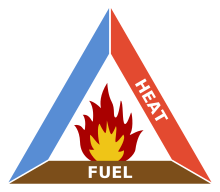Key Points:
- Wet hay may heat and cause a fire.
- Immature hay and early first-cut hay may retain stem moisture where a meter cannot detect it.
- Call the fire department immediately if you suspect a hay fire.
What Causes Fires?
- Hay that is too wet (above 25% moisture) will heat and then enter the spontaneous combustion cycle.
- A large mass of forage allows heat to build up (fuel + heat).
- A slow trickle of air adds oxygen to the hot fuel.
The process of forage heating up and then burning is typically called spontaneous combustion. Spontaneous combustion for hay usually occurs within the first two months of storage. Unusual growing conditions, such as an early harvest window or immature crop, can complicate the drying process and increase the risk of fire.
Spontaneous heating and combustion occur when sufficient moisture (above 25% and below 45% moisture content for forages), oxygen (air) and organic matter are present together to support the growth of bacteria and moulds. This growth results in an initial temperature peak of 54°C–65°C. When the forage reaches this temperature range, a chemical process called the Maillard Reaction may occur, causing additional heat generation. This reaction can be self-sustaining and does not require oxygen (air) to continue. The gases produced will ignite if they have reached a high enough temperature and are exposed to oxygen (air).

Fire Prevention
The moisture of the hay is the main factor in forage fires. To reduce this burning issue, know the crop moisture content. Buy a moisture tester or use your microwave oven to determine the moisture content. Wet bales may not stack as well or hold their shape.

| Bale Type | Recommended Storage Moisture (%) | Recommended Dry Matter Content (%) |
| Small squares | 15-18 | 82-85 |
| Large rounds: soft core | 13-16 | 84-87 |
| Large rounds: hard core | 12-15 | 85-88 |
| Large squares | 12-14 | 86-88 |
For hay above recommended moisture levels, a hay dryer should be used. Stack hay on edge to keep bale shape and allow some air flow. Large bales, due to their higher density and greater volume, inhibit dispersal of heat and moisture. Therefore, large bales will burst into flames easier than small square bales if baled too wet.
Many farmers sprinkle salt on hay as it is stored, in an effort to prevent hay fires. However, tests have shown that salt has no effect on controlling spontaneous combustion. Dry ice, liquid nitrogen or carbon dioxide gas pumped into the hay will prevent combustion by eliminating the oxygen from the hay mass.
Check hay regularly. A slight caramel odour or a musty smell are signs that the hay may be heating.
The Fire Danger Zone
When it is evident that hay is heating, the primary goal is to measure the temperature by probing the hay with a homemade device similar to that shown in Figure 2. Probing will determine if there is a fire and its location, or it will help assess the likelihood of a fire. Use the temperature information in Table 2 to help in the decision-making. The simplest test is to stick an iron or copper rod deep into the centre of the forage and leave it for about an hour. If it’s almost too hot to hold when removed, there is a problem.
A probe can be made from a 3-m (10-ft) piece of electrical tubing. Rivet a hardwood pointed dowel to one end and drill eight 5 mm (1/4 in.) diameter holes in the tube just above the dowel. Drive the probe into the hay mass and lower a candy thermometer on a long string into the probe. The thermometer should be left for 10 minutes to ensure an accurate reading.

| Temperature | Action |
| 65 C | Check temperatures daily. Below this point, temperatures are not considered abnormal, although anything above 52 C is unusual. |
| 70 C | Danger! Measure the temperature every 4 hours and inspect the hay storage. |
| 80 C | Call the fire department! Keep all doors and other openings closed to prevent drafts, which add oxygen to the fire. Remove animals and tools from the structure without touching the hay. With help from the fire department, wet the hay down and remove it from the barn. Forage above 82 C may burst into flame when exposed to air. Hay should be placed a good distance away from buildings as it is removed from storage in case it starts to burn. |
Extinguishment Procedures
For hay storage, heating is often confined to a pocket within the storage. Attempting to remove this pocket should only be done when the fire department is there with a water truck, since the material may flame when exposed to air. Removal of hay may be accomplished by using a High-Hoe or a logging clam. Hay should be placed a good distance away from the barn in case it starts to burn.
If the fire is so active that it must be extinguished in the barn, wet the hay and remove it immediately. Workers must be aware of the potential for collapse of bridged hay over fire cavities in the barn.
Extreme caution should be taken when fighting a hay fire if hay has been treated with chemical preservatives. Hay treated with preservatives containing ethoxyquin and butylated hydroxytoluene (BHT) will produce hydrogen cyanide gas at around 115°C (240°F). This gas is very deadly. Additives containing primarily propionic acid do not produce hydrogen cyanide during a fire.
